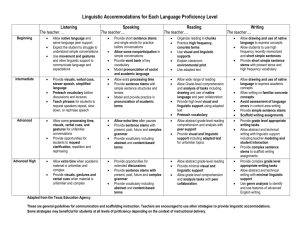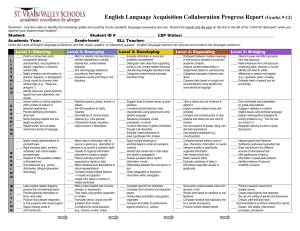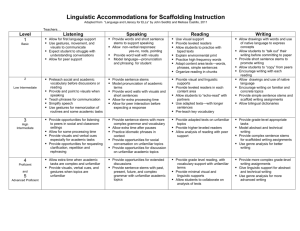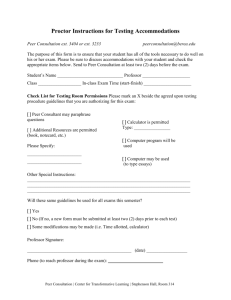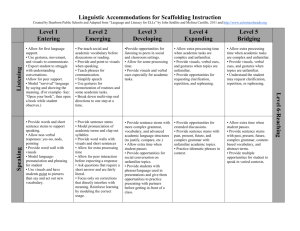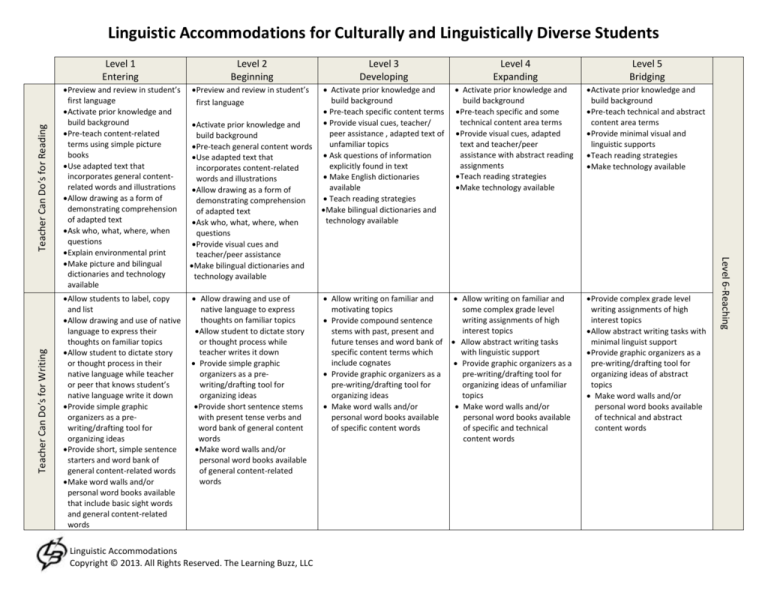
Level 2
Beginning
Level 3
Developing
Level 4
Expanding
Level 5
Bridging
Preview and review in student’s
first language
Teacher Can Do’s for Reading
Preview and review in student’s
first language
Activate prior knowledge and
build background
Pre-teach content-related
terms using simple picture
books
Use adapted text that
incorporates general contentrelated words and illustrations
Allow drawing as a form of
demonstrating comprehension
of adapted text
Ask who, what, where, when
questions
Explain environmental print
Make picture and bilingual
dictionaries and technology
available
Activate prior knowledge and
build background
Pre-teach specific content terms
Provide visual cues, teacher/
peer assistance , adapted text of
unfamiliar topics
Ask questions of information
explicitly found in text
Make English dictionaries
available
Teach reading strategies
Make bilingual dictionaries and
technology available
Activate prior knowledge and
build background
Pre-teach specific and some
technical content area terms
Provide visual cues, adapted
text and teacher/peer
assistance with abstract reading
assignments
Teach reading strategies
Make technology available
Activate prior knowledge and
build background
Pre-teach technical and abstract
content area terms
Provide minimal visual and
linguistic supports
Teach reading strategies
Make technology available
Allow students to label, copy
and list
Allow drawing and use of native
language to express their
thoughts on familiar topics
Allow student to dictate story
or thought process in their
native language while teacher
or peer that knows student’s
native language write it down
Provide simple graphic
organizers as a prewriting/drafting tool for
organizing ideas
Provide short, simple sentence
starters and word bank of
general content-related words
Make word walls and/or
personal word books available
that include basic sight words
and general content-related
words
Allow writing on familiar and
Allow writing on familiar and
motivating topics
some complex grade level
writing assignments of high
Provide compound sentence
interest topics
stems with past, present and
future tenses and word bank of Allow abstract writing tasks
specific content terms which
with linguistic support
include cognates
Provide graphic organizers as a
Provide graphic organizers as a
pre-writing/drafting tool for
pre-writing/drafting tool for
organizing ideas of unfamiliar
organizing ideas
topics
Make word walls and/or
Make word walls and/or
personal word books available
personal word books available
of specific content words
of specific and technical
content words
Provide complex grade level
writing assignments of high
interest topics
Allow abstract writing tasks with
minimal linguist support
Provide graphic organizers as a
pre-writing/drafting tool for
organizing ideas of abstract
topics
Make word walls and/or
personal word books available
of technical and abstract
content words
Activate prior knowledge and
build background
Pre-teach general content words
Use adapted text that
incorporates content-related
words and illustrations
Allow drawing as a form of
demonstrating comprehension
of adapted text
Ask who, what, where, when
questions
Provide visual cues and
teacher/peer assistance
Make bilingual dictionaries and
technology available
Allow drawing and use of
native language to express
thoughts on familiar topics
Allow student to dictate story
or thought process while
teacher writes it down
Provide simple graphic
organizers as a prewriting/drafting tool for
organizing ideas
Provide short sentence stems
with present tense verbs and
word bank of general content
words
Make word walls and/or
personal word books available
of general content-related
words
Linguistic Accommodations
Copyright © 2013. All Rights Reserved. The Learning Buzz, LLC
Level 6-Reaching
Level 1
Entering
Teacher Can Do’s for Writing
Linguistic Accommodations for Culturally and Linguistically Diverse Students
Level 1
Entering
Level 2
Beginning
Level 3
Developing
Level 4
Expanding
Level 5
Bridging
Allow same language peer and
native language support
Pre-teach content-related
words prior to discussions
Use visuals and have students
point to pictures or act out
vocabulary
Use gestures, movement, point
and model to scaffold
instruction
Speak slowly using simple
language but use correct
English wording
Ask yes/no questions
Use cognates
Allow same language peer and
native language support
Pre-teach general content
words prior to discussions
Model clear instructions of
academic tasks using visuals and
real objects
Use simplified language, visuals,
slower speech and cues
Ask questions that can be
answered in short phrases or
with a yes/no
Use cognates
Use gestures, movement, point
and show to demonstrate
understanding
Allow same language peer and
native language support when
appropriate
Pre-teach specific content terms
prior to discussions
Model clear instructions of
academic tasks using visuals and
real objects
Use a combination of simplified
and complex language
accompanied by visuals , slower
speech and verbal cues for
material that is unfamiliar
Pre-teach specific and some
technical content area terms
Model clear instructions using
some visuals
Use complex language
accompanied by visuals , slower
speech and verbal cues when
material is unfamiliar and
complex
Pre-teach technical and abstract
content area terms
Model clear instructions
Use complex language
accompanied by visuals and
verbal cues when material is
complex and abstract
Respect students’ silent period
Allow extra wait time
Allow one word answers
Allow students to contribute to
class discussions in their first
language and have a peer that
understands the native
language restate the answer in
English
Provide short sentence stems
and word bank of general
content-related terms
Respond positively to students
efforts to speak English and
repeat back what they said by
modeling correct grammar and
vocabulary
Model pronunciation of
academic terms
Allow students to participate in
activities that promote student
to student interaction
Allow wait time for students to
respond to questions
Model a phrase and have the
student repeat it
Provide short sentence stems
with present tense verbs and
word bank of general content
words
Ask students to point to
pictures and say the new word
Avoid excessive error correction
but reinforce learning by
modeling correct language
usage
Allow students to participate in
activities that promote student
to student interaction and
discussions
Allow wait time for students to
respond to questions
Provide simple sentence stems
with past, present and future
tenses and word bank of
specific content terms which
include cognates
Ask students to elaborate on
one word responses
Allow students to participate in
activities that promote student
to student interaction,
discussions
Allow sufficient wait time to
respond to questions of
unfamiliar topics
Provide more elaborate
sentence stems that
incorporate complex
grammatical structures
Provide a word bank of specific
and some technical contentarea terms
Ask students to elaborate on
other students responses
Have students paraphrase and
summarize ideas presented by
teacher or other students
Allow students to participate in
activities that promote student
to student interaction and
discussions
Allow wait time to respond to
questions of abstract topics
Provide a variety of compound
and complex sentence starters
to discuss and give examples of
abstract content-based ideas
Allow students to participate in
activities that promote student
to student interaction,
discussion and elaboration
Linguistic Accommodations
Copyright © 2013. All Rights Reserved. The Learning Buzz, LLC
Level 6-Reaching
Teacher Can Do’s for Speaking
Teacher Can Do’s for Listening
Linguistic Accommodations for Culturally and Linguistically Diverse Students
Linguistic Accommodations for Culturally and Linguistically Diverse Students
Linguistic Accommodations
Copyright © 2013. All Rights Reserved. The Learning Buzz, LLC

